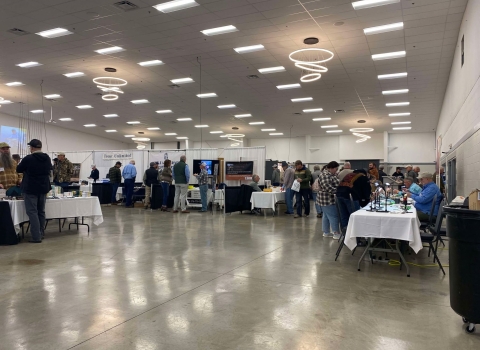Water provides a lifeline in the desert. And millennia ago, water also provided something much bigger – change. Catastrophic river floods were once a regular part of the natural history of the Rio Grande Valley. Today at Bosque del Apache National Wildlife Refuge we work hard imitate the Rio Grande’s natural history in order to take care of the wildlife we protect. Surprisingly, fire is one tool that can recreate natural processes that the river once did.
The Rio Grande and Natural Renewal
To understand what natural processes were here at Bosque del Apache National Wildlife Refuge, let’s go back in time and picture the historic Rio Grande. The narrow and seasonal river that we see running through the refuge today is only a remnant of a once incredible force. For thousands of years the Rio Grande was mighty and had a mind of its own. It might flow slow and wide one year, then the next year become a raging body of water that flooded and moved miles of land. Sudden major flood events would wreak havoc on bosque ( riparian riparian
Definition of riparian habitat or riparian areas.
Learn more about riparian forests) and surrounding desert shrublands, but also renew them by turning over essential nutrients and exposing bare ground where new plants could grow. Today, the river is very different. Today’s Rio Grande is controlled by canals and dams so that it won’t destroy cities and can take care of people for food and household water.
Why is the history of the river important? Native species of plants still need that constant change to thrive. The plants need new nutrients, and the forests need bare soil for fresh young plants to grow – just as they once did before humans changed the river. The taming of the river makes the surrounding land vulnerable to non-native plant species taking over. Additionally, fallen limbs and dead trees start to build up where they never did before and thus create a hazard for if lightning were to spark on the refuge. Undesired non-native species such as salt cedar, Russian olive, kochia, and Siberian elm start to grow thick. These non-native plants provide poor homes and nutrition for the native species that we protect – migratory ducks, endangered small mammals, and threatened forest bird species. We can renew the land by carefully using fire to redistribute nutrients, clear woody species overgrowth, and remove non-native plants.
“Prescribed fires” are used to change the landscape in a predictable way. Prescribed fires are a tool, not a catastrophe. They are different from wildfires because our prescribed burns are controlled, highly managed, and not “wild” at all. For us, prescribed fires are the result of careful planning with the goal of restoring a habitat to native plants and return valuable nutrients to the soil and encourage new plant growth.
What does that look like today?
In 2021, heavy equipment pulled out non-native trees like salt cedar and Russian olive and placed them in large piles. You may have seen the stacks along the edge of the North Tour Loop. These piles and the nearby savannah were recently scheduled for prescribed burning. Wildland fire-crews arrived at the refuge in early March of 2022 to burn the piles of limbs and surrounding vegetation to return nutrients to the soil and reset the plant life.
When you look at the burned parts of our refuge now, they may look bleak and dead. Just wait. Over time, blackened soil will begin to sprout with thickly budding yerba mansa flowers, thin golden wisps of sacaton, and fragrant mesquite shrubs. Tender green shoots of salt grass will emerge to replace the dry salt cedar. The land will transform.
This is where fire meets water. The pattern of destruction and regeneration is a healthy and normal cycle for the landscape. Although humans are now imitating the work of the once-wild Rio Grande, the response of the plants and wildlife can show that these tools are working: new places for wildlife to eat, nest, and rest. Perhaps soon endangered desert species will expand their known range within the refuge, and in turn, show us that the landscape is returning to a historic abundance of life.


